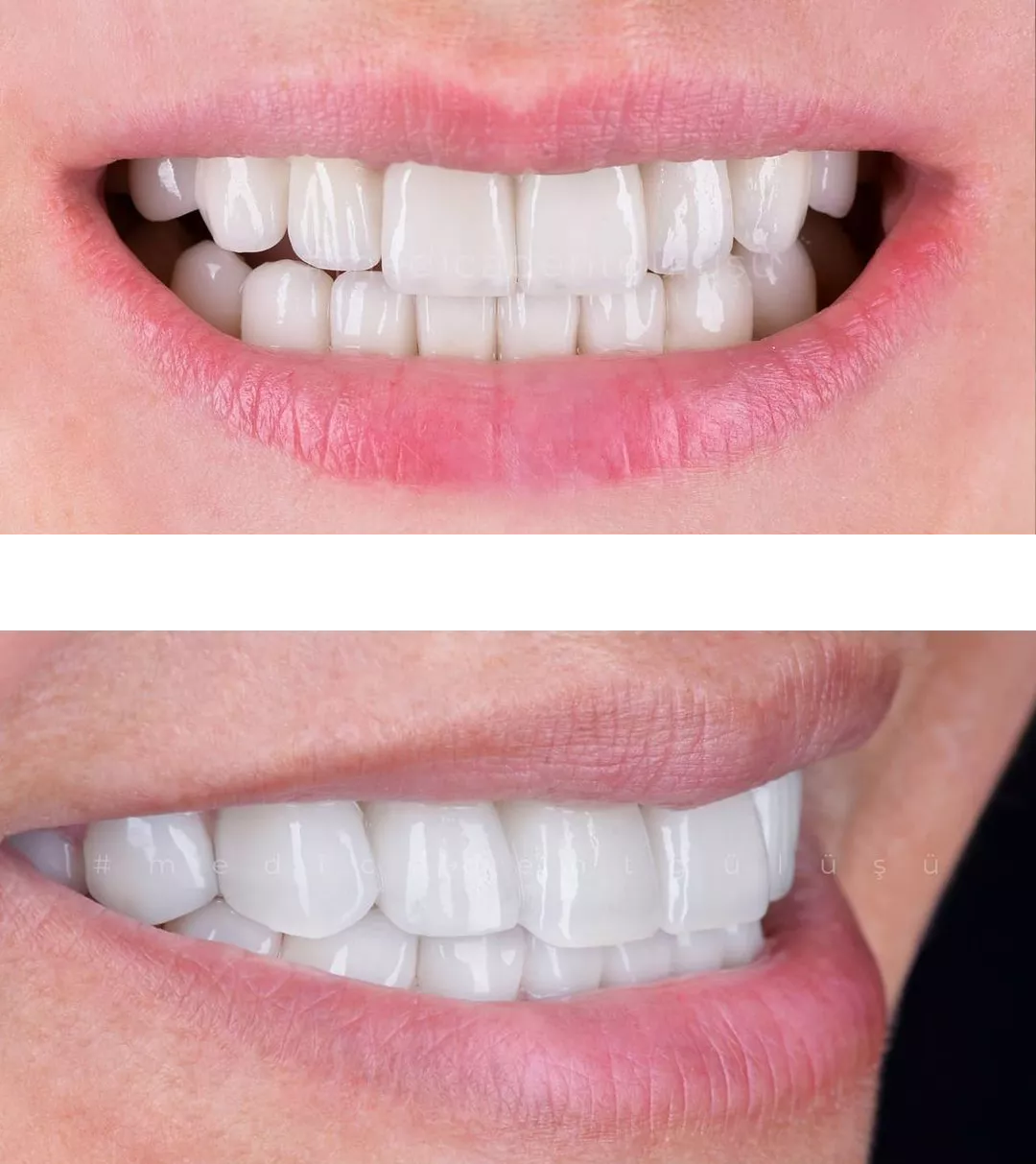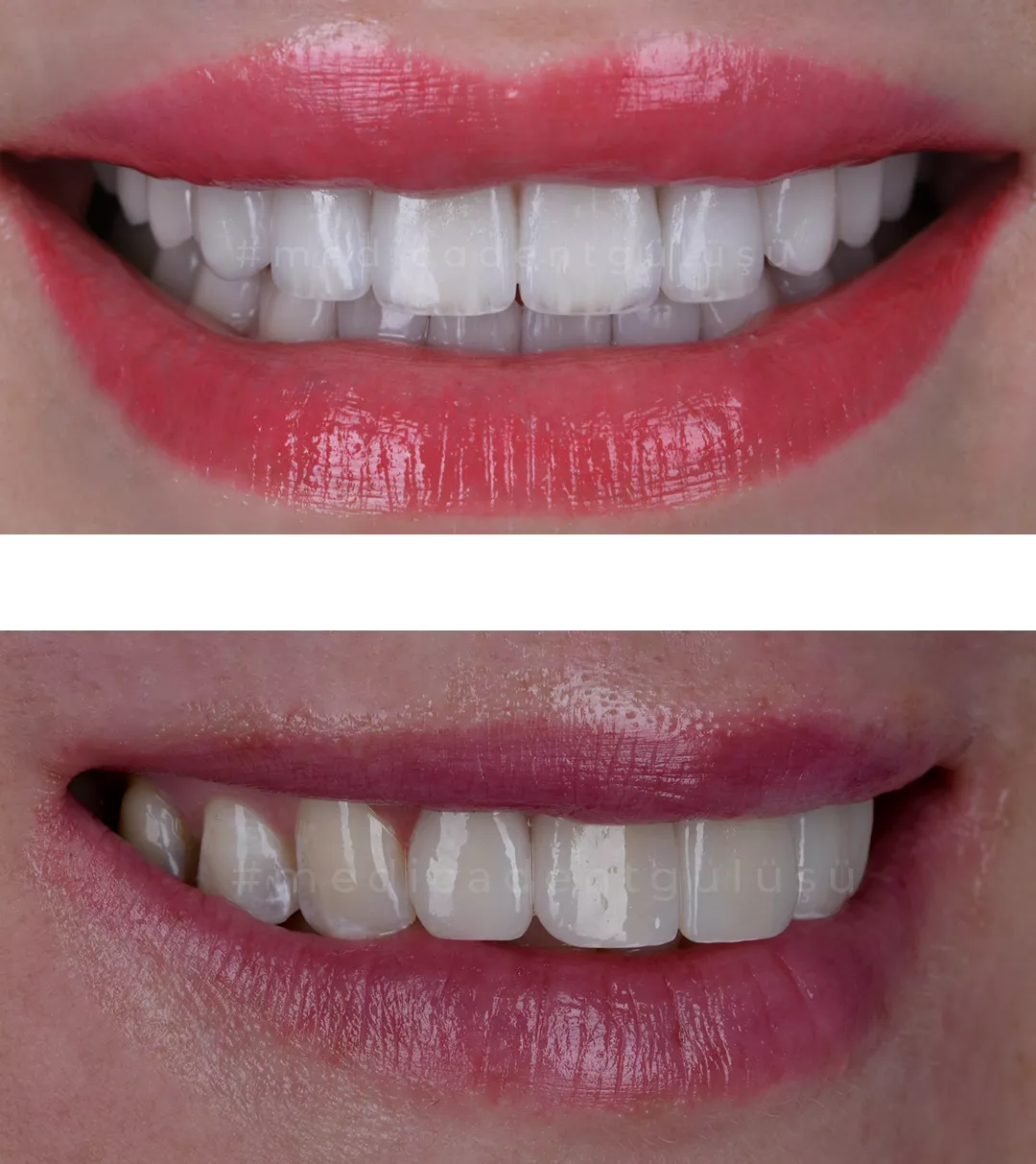Aesthetic dentistry > Laminated veneers

It is possible to completely change your smile with restorations called "leaf prostheses", which we call lamina. These are extremely thin and are attached only to the front surface of the teeth.
Before any intervention on the teeth, we can show you in advance how your teeth will look in your mouth, in a digital 3D image, after the application with mock-up techniques. Therefore, you can see what the result will look like before you even begin your treatment.
Fine-structured porcelain laminates provide a bright appearance on the teeth with their transparency, like natural tooth enamel. This property if often preferred in smile design due to its superior aesthetic properties.
First, your dentist will examine your teeth in detail by photographing them and discussing your wishes, expectations and values. This will help the dentist understand if this treatment is right for you. Because, like all other applications, this process may not be suitable for everyone.
If the patient is happy with the two-dimensional design, the process can be started or, if desired, transferred to a different program. The desired sizing and shaping are made and a “three-dimensional" digital modelling is made in accordance with the finished shape, and a personalized mock-up plate is obtained. With this plaque, the smile shape of the patient is shown practically on their own teeth. If desired, modifications can be made on it, or the ideal result can be obtained without any further processing. Thus, it is possible to start the process right away.
If the gingiva requires contouring (a shape change) in the Mock-Up application, laser sizing and symmetry is completed on by taking the plaque boundaries as a guide. This process is called pink aesthetics. For the aesthetic result, pink aesthetics is as important as the production of lamina, which we call white aesthetics.
If any changes have been made to teeth (e.g., tooth preparation for dental laminates), the final state of the teeth is scanned with a camera on the mock-up material and sent to our laboratory.
The desired colour is determined by common decision between the dentist and the patient.
Laminas are prepared in the light of all this in our laboratory and are delivered to the clinic and are studied, with corrections made if necessary, before they are adhered to the teeth with special bonding materials.


There is usually no pain during the procedure. However, in some cases, local anaesthesia can be used to ensure that the patient does not feel any pain during the procedure. After the procedure, temporary laminates will be placed to protect the patient's teeth until the bonding session. Therefore, until the next session, the patient does not experience an aesthetic problem and sensitivity is prevented.
In the first session, the tooth surface will be prepared so that the porcelain laminates can be placed. Approximately 0.3-1 millimetre of enamel tissue will be removed from the front surface of the tooth and an impression will be taken. With this measure, porcelain laminates will be produced in the desired colour and form suitable for the tooth, to complete the smile, almost in leaf thickness. They will be adhered to the tooth with special adhesives, also in the appropriate colour.
No-Prep Veneer is a laminate veneer (leaf porcelain) application that is made by taking measurements directly, without damaging the original surface of the tooth.
Its difference from the classical laminate veneer is that it is applied without any preparations such as roughening or abrasion on the tooth surface. Unprocessed veneers are a very successful method in terms of getting quick and aesthetic results in problems such as colour problems, loss of tooth structure and gap problems in the teeth.
They are adhered to the teeth one by one with a special bonding technique, and since they are supported by the natural tooth, their durability is similar to the original tooth. Even if the tooth decays from the inside, the veneers are not damaged. Due to the material, they are not easily discoloured, and they can reflect advanced colour changes that may occur in the teeth because they are very thin.
No-prep veneers can be used comfortably for long periods of time. As with any type of dental restoration, good maintenance and regular inspection will prolong the lifespan.
Laminate veneers are preferred when the tooth colour is very dark, and more than a few shades of whitening is desired if the teeth are cramped or in a position that absolutely requires abrasion.
No-prep veneer are preferred if the teeth are small in size, if there is a gap between the teeth and only a few shades of whitening are required.
In laminate veneer applications, some abrasion is performed on the enamel surface and then the laminates are adhered to the tooth surface, while in no-prep veneer applications, the enamel layer is not abraded at all.
If laminate veneers are removed, new laminates must be made. If no-prep veneers are removed, the teeth can continue to be used in their original form.
In terms of price and aesthetic result, the most appropriate treatment is performed with the right indication.


Click on one of our members to chat on WhatsApp or send us an email at info@gloriadentravel.com
You can also call us at +34 674 224 346 during business hours.